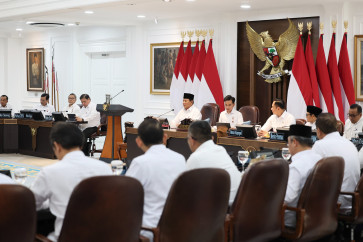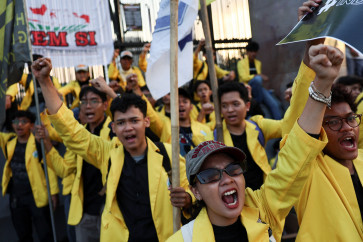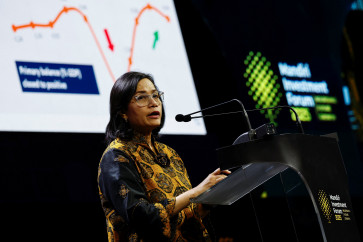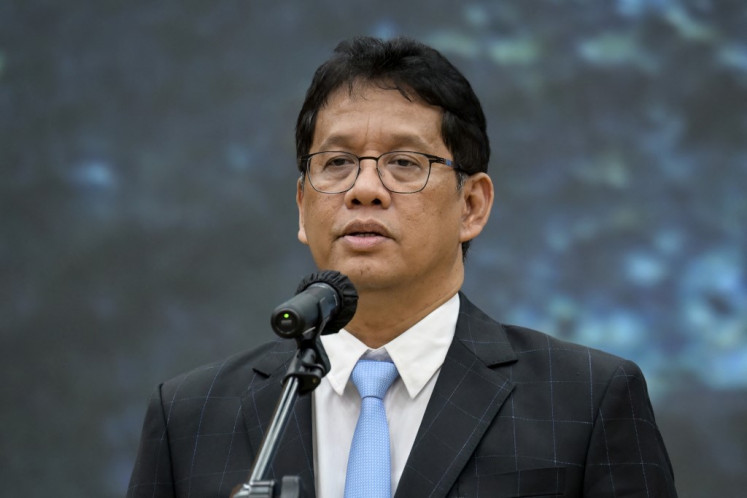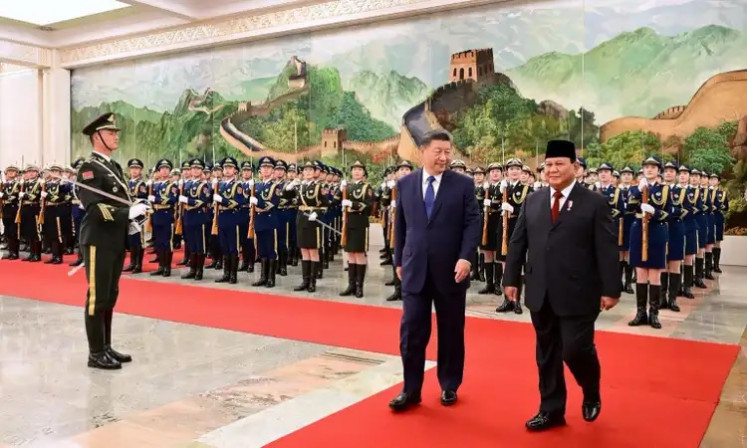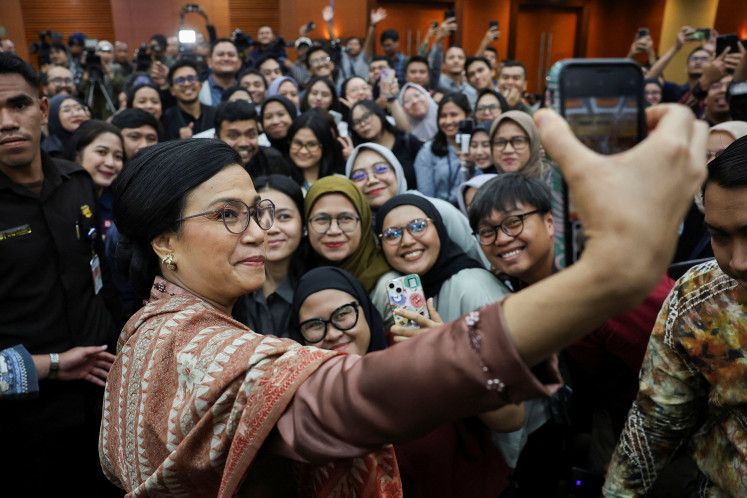Popular Reads
Top Results
Can't find what you're looking for?
View all search resultsPopular Reads
Top Results
Can't find what you're looking for?
View all search resultsCoffee enlightenment: Fruity, light, hand-made
Craftmanship: A filter bar at One-Fifteenth Coffee that features various equipment for hand-brewed java
Change text size
Gift Premium Articles
to Anyone
Craftmanship: A filter bar at One-Fifteenth Coffee that features various equipment for hand-brewed java. (JP)
When Starbucks ventured into Jakarta in 2002, it was hardly considered a pioneer in the Indonesian coffee culture.
Almost every region has its own tradition of java. In Aceh and other Chinese and Malay-influenced regions, kopi tiam coffee with condensed milk is the norm in public hangouts. In the higher terrains of West Sumatra, such as Bukittinggi and Padang Panjang, farmers, who had ceded their crops to the Dutch, developed kopi kawa, a tea-like beverage made with coffee leaves. In Yogyakarta, the city's street-side stalls have developed kopi joss or kopi arang, in which regular sweet coffee has a piece of burning charcoal in it, giving it a strong burned aroma.
Excelso, a chain developed by PT Santos Jaya Abadi, a large producer known for its Kapal Api brand, started opening Western-style coffee shops in the early 1990s.
What the American corporation brought here is style in serving coffee, where cup sizes and menus have their own vocabulary (what were grande and fenti, again, before Starbucks?). Known for the Italian principle of making espresso-based drinks, it values its aproned baristas that master the coffee machines and milk measurements to craft the drinks.
'I was working in a Starbucks-influenced chain in Yogyakarta, this was the second generation of coffee that emphasized espresso,' said Morph Coffee roaster and national champion barista Doddy Samsura.
When he was asked to join a new café in Jakarta ' later named One-Fifteenth Coffee ' he said it was a completely new experience, where the espresso was only a part of the craft.
'The third wave means we put forward quality, departing from mass production,' he said.
American roaster and barista Trish Rothgeb, among the first to popularize the term 'third wave' in the coffee industry, wrote in The Flamekeeper newsletter in 2003 that artisanal coffee that puts attention on bean origin and roasting style is actually still part of the second wave.
The third wave she describes as 'every outlet that opens with a semi-automatic espresso system [where a barista] working overtime, staining her hands brown with coffee as she handcrafts the perfect shot.
'[It] is a reaction to those who want to automate and homogenize specialty coffee.'
The first wave of coffee is often associated with canned coffee and the acknowledgement of countries of origin, like Colombia's Juan Valdez coffee campaign in which a fictional farmer character was used to represent its local coffee.
The wave was a correction of the war-time type of coffee serving where low-grade beans were blended from everywhere in the absence of good production.
According to James Freeman's The Blue Bottle Craft of Coffee, espresso came into fashion in Italy during the postwar years when most coffee available was low-grade Brazilian coffee and rubbery-tasting Robusta from North Africa.
The drive to craft the best shots of coffee has seen the flourishing of hand-made brews using plungers and drippers for the past decade while the best-grown beans are still hunted worldwide.
Doddy said that at One-Fifteenth and Morph Coffee, baristas were trained to look for sweet and pleasant fruity acid flavors in their servings.
Limiting their art to local and foreign Arabica, he said that salty was considered a defect while bitter was the one to avoid in roasting. The coffee house now sticks to beans from two regions ' Dolok Sanggul in North Sumatra and Ciwidey in West Java ' for its regular blend.
But as consistent local crops at a good price are hard to come by, the house is open to varieties from Rwanda, Brazil and Ethiopia, which it purchases from a Singaporean trading company.
Aston Utan, an owner and barista at Pandava Coffee and Common Grounds, considers his coffee houses American as they look for brightness in Arabica, as favored by many cafes on the US' west coast.
'We love Indonesian coffee, but we don't want to limit ourselves to it. We really want different kinds of coffee that people can really enjoy,' he said.
Aston said the current house blend consisted of a mix of Aceh, Toraja and Ethiopian Yiragacheffe, which he said worked in espresso and in milk.
He said getting quality beans was generally not a problem, since the family of the co-owner, Daryanto Witarsa, had a coffee exporting company, which gains wide connection with global coffee trade.
Despite the domination of Arabica in coffee houses, Rumah Kopi Ranin tries to highlight local Arabica and Robusta on its premise in Bogor.
Tejo Pramono and roaster Uji Sapitu, who co-own the cafe, are convinced that the specialty coffee movement should benefit farmers and consumers as it shifts farmers away from the poor producing techniques and low-grade coffee.
'Many Indonesian farmers don't realize the quality of their coffee simply because a few Indonesian coffee drinkers appreciate good coffee,' said Tejo, who is also an activist with La Via Campesina, an international peasant movement.
Having a good connection with farmers, he often holds cupping events for farmers from various places at the coffee house.
Currently the coffee house ' although relatively modest in style compared to most Jakarta coffee houses ' features noted Indonesian Arabica such as Aceh and the currently most-coveted Papuan coffee from Wamena, which is not always available at other cafes.
It also features several fine Robusta from Manoreh (Yogyakarta) and Toraja Mamasa (South Sulawesi).
An owner of Philocoffee Project that sells coffee equipment and also a coffee blogger, Hardiansyah Suteja, said that the sales of hand-made coffee equipment had experienced a boost since last year.
'More people are interested in making better coffee at home, although the trend started at cafes,' he said.
Hardiansyah said the hand-brewing equipment especially interested people from Kalimantan and Sumatra, as they often experienced electricity problems.
'The hand-brewing equipment is cheaper than coffee machines,' he said.
Hardiansyah said that as the coffee community had developed over the years, the government as well as coffee houses should help farmers get good prices for their beans.
'People here often try to get direct access to farmers to get lower prices, but they don't buy in large quantities. It would be more profitable for them to export,' he said.


